In a previous post, we discussed why a strong brand is critical to your nonprofit’s success. So hopefully the question of why is clear, but the question of what—just what is nonprofit branding?—might be a little fuzzier.
What actually goes into a great nonprofit brand? How can you create a brand that furthers your mission? How should brand strategy impact your nonprofit’s website redesign?
Well, according to this article on Nonprofit Quarterly, it’s famous CEOs and impressive funders that make fir strong nonprofit branding. But to be honest, we couldn’t disagree more! These things are nice to have and can definitely elevate an existing brand… but they don’t create the brand and they shouldn’t drive the brand strategy.
Instead, here are the 6 key “branding keys” for your nonprofit:
- Values
- Differentiators
- Audience
- Storytelling
- Transparency
- Design + Copy
Nonprofit Branding Key #1: Values
The single most important aspect of nonprofit branding is your values. And by values, we’re encompassing everything that goes into the deeper why of what you do:
- What drives your organization?
- Why does your staff get up in the morning?
- What are you unwilling to compromise on?
- Why do you behave the way you do?
Your nonprofit’s core values drive your mission (what you do) and your vision (how you see a better world).
The key with your brand values is to be honest and authentic. You’ll connect with your community on a much deeper level if you can clearly express your values.
A great example of core values at work is Patagonia.
Patagonia doesn’t just sell outdoor gear. This is a company that pays attention to the human and environmental cost of every item they produce and every item you buy. They’re proud to share what they stand for because they want customers who agree with their mission and will help carry out their vision.
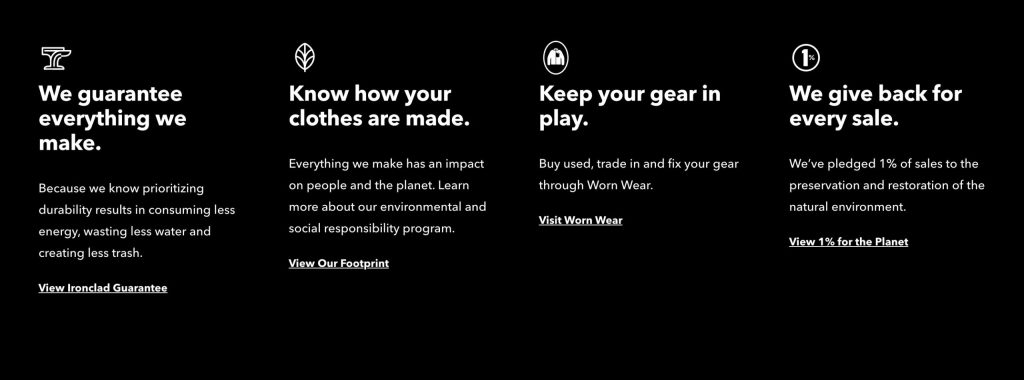
Nonprofit Branding Examples: Core Values at Work
To look at a nonprofit specifically, consider how unique core values have translated into the branding of Avenidas.
This organization’s goal, in their own words, is to “create a community that supports and celebrates older adults.” You can immediately feel this value of celebration in the vibrant, playful colors as well as the friendly tone of voice. While this nonprofit hasn’t listed their values on their website, I’d imagine they revolve around encouragement, affirmation, inclusivity, celebration, and creativity—which you can clearly see embodied in their website.
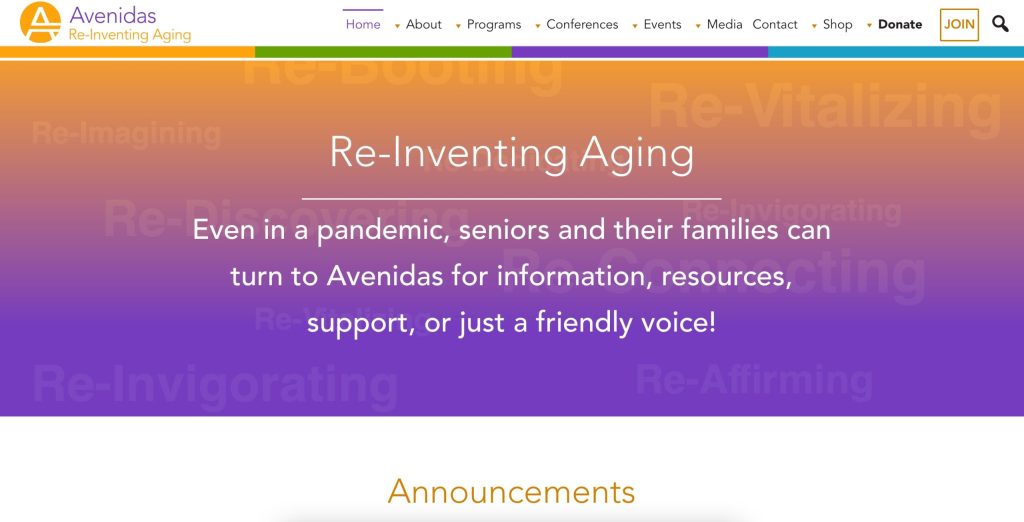
Many elder care nonprofits don’t use such a vibrant, youthful brand—but Avenidas is all about celebrating age in all its glory. This is a fresh and welcome message and can inspire people who may be dealing with a difficult transition into their older years (or those of their loved ones).
The Dallas Area Rape Crisis Center is another fantastic example of how values and beliefs can effectively drive a nonprofit’s mission and its brand expression. They don’t simply help people who are dealing with sexual assault—they believe them. Their values and mission are captured in a manifesto-style paragraph front and center on their home page.
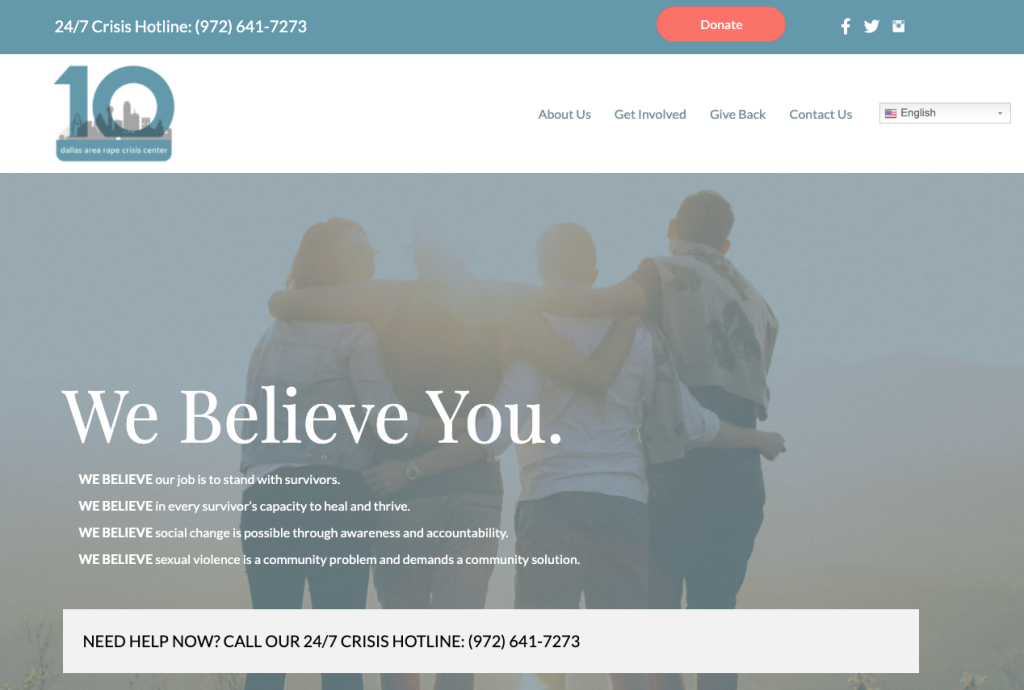
The Lonely Whale is another good example of a nonprofit proudly displaying their values and guiding principles. These values drive their mission and their brand identity.
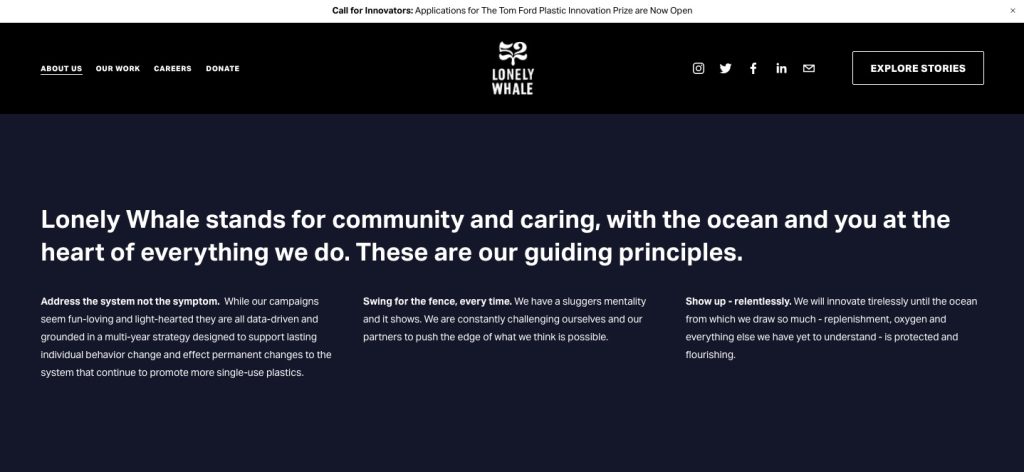
Theoretical Example: How Core Values Drive Nonprofit Branding
I know I often learn best by comparison, so how about a little comparison to illustrate this point?
Imagine two organizations that provide some kind of donation-based resources to people in developing countries.
One of these orgs may value accountability and dignity—they know that lots of people donate to communities in emerging countries but really don’t vet the items they give. The end result is usually a collection of, let’s be honest, trash. (Well-intentioned trash…but trash nonetheless.) So this organization seeks to give truly high-quality items that dignify the people they help—never, ever junk. These core values are what they are unwilling to compromise on.
Another organization doing the exact same thing might instead value empowerment. They donate resources because they know that women in these countries spend inordinate amounts of time on basic tasks, and they want to give women the power to manage their own time. Of course, they don’t want to give junk, either—but what truly sets them apart is the value of empowerment, which drives their mission, vision, and operations.
These are two organizations in the exact same space but powered by very different core values. And their nonprofit branding should be just as different!
Nonprofit Branding Key #2: Differentiators
Another important component to a successful brand strategy is your nonprofit’s differentiators. Often called “positioning,” your differentiators are exactly what they sound like. They’re the answer to the question:
What makes you different?
Given the hundreds of nonprofits and other impact organizations that do what you do…
- Why should someone join your mission?
- Why should someone donate their precious time or money to help you?
- Why should a grant reviewer decidethat you are the best nonprofit to receive their limited funds?
Assuming that people will support you simply because they’re aligned to your overall vision is a big mistake. There are thousands of nonprofits out there, and none of us can donate to every organization we happen to agree with.
To move someone from plain agreement into active support and even advocacy, you have to tell them why you are worth their time, money, and effort. In the eyes of your ideal donor/volunteer/funder/activist, why are you the nonprofit to join?
But This Isn’t a Competition, Is It?

Some nonprofits are hesitant to emphasize their differentiators because they feel like it creates a sense of competition that shouldn’t exist in the nonprofit space. We agree in the sense that you don’t need to call out specific organizations or say something like, “Hey! We’re better than those guys over there!”
At the same time, though, we need to be realistic.
In the minds of potential donors, volunteers, corporate partners, and grant reviewers, your nonprofit is constantly being compared to others that are similar to you.
This is just human nature.
Where there is choice, we will always make comparisons in our minds. It’s the only way that we can process information.
So while it’s not a competition, it is a comparison—and you need to tell your audience how you stack up.
If you don’t tell them, then it’s not like they won’t make the comparison. They’ll just do it themselves based on their own impressions. And their comparison may or may not reflect the hard work you’re doing and the impact that you’re making.
Identifying Your Nonprofit’s Key Differentiators
Not sure what your nonprofit’s differentiators are? Here are some essential questions to consider:
- How does your nonprofit’s approach differ from other groups?
- What programs are unique to you?
- Why do you have the unique capacity to tackle this issue?
- What experiences or background does your staff bring that gives you keener insight into this issue?
- What’s a surprising fact about your organization, leadership, or operations?
- How do you develop programming?
- How long have you been established?
- How many volunteers, partners, or donors do you have?
- Have you earned recognition from any thought leaders in your area of work?
Tip: Ask your tribe! Talk to your donors, volunteers, board members, and beneficiaries. Their insight will be amazingly helpful at understanding the position you occupy in their minds.
Nonprofit Branding Examples: Differentiators
New Story puts a clear differentiator within their three key values: “Unlike most housing nonprofits, we ask before we build.”
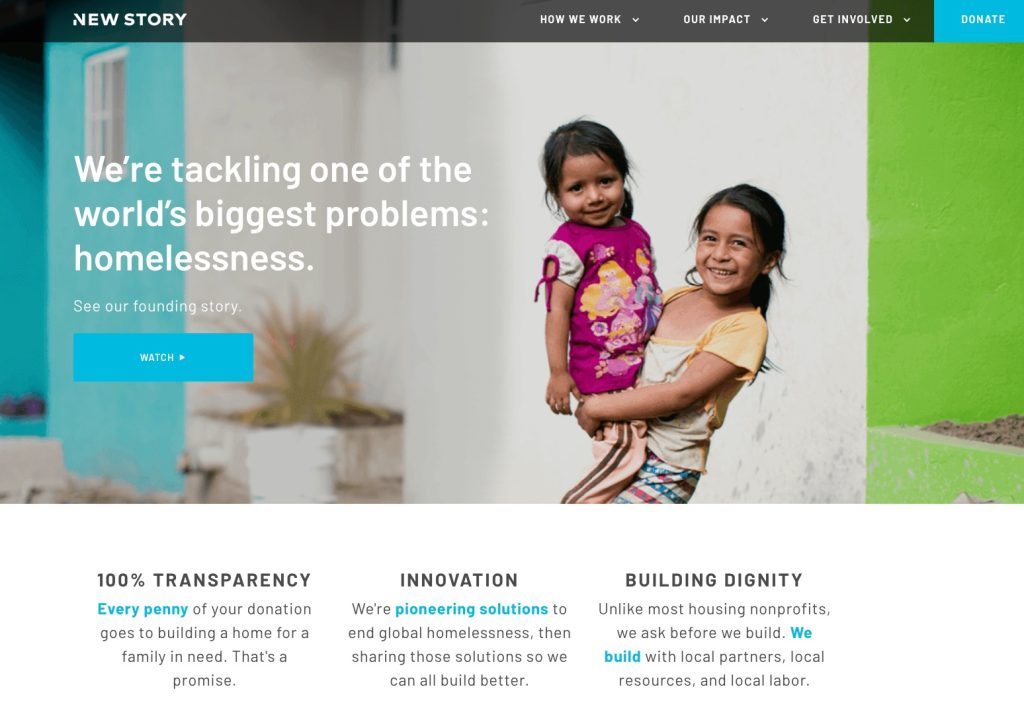
Friends of the Earth is a good example of differentiators in action, although it’s less obviously worded as New Story’s.
This organization never says, “We’re different because XYZ”—but they do clearly set themselves apart with their powerful (almost aggressive) approach, which shows up in everything from the sword icon to words like fearless, hard-hitting, outspoken, truth to power, and activist base.
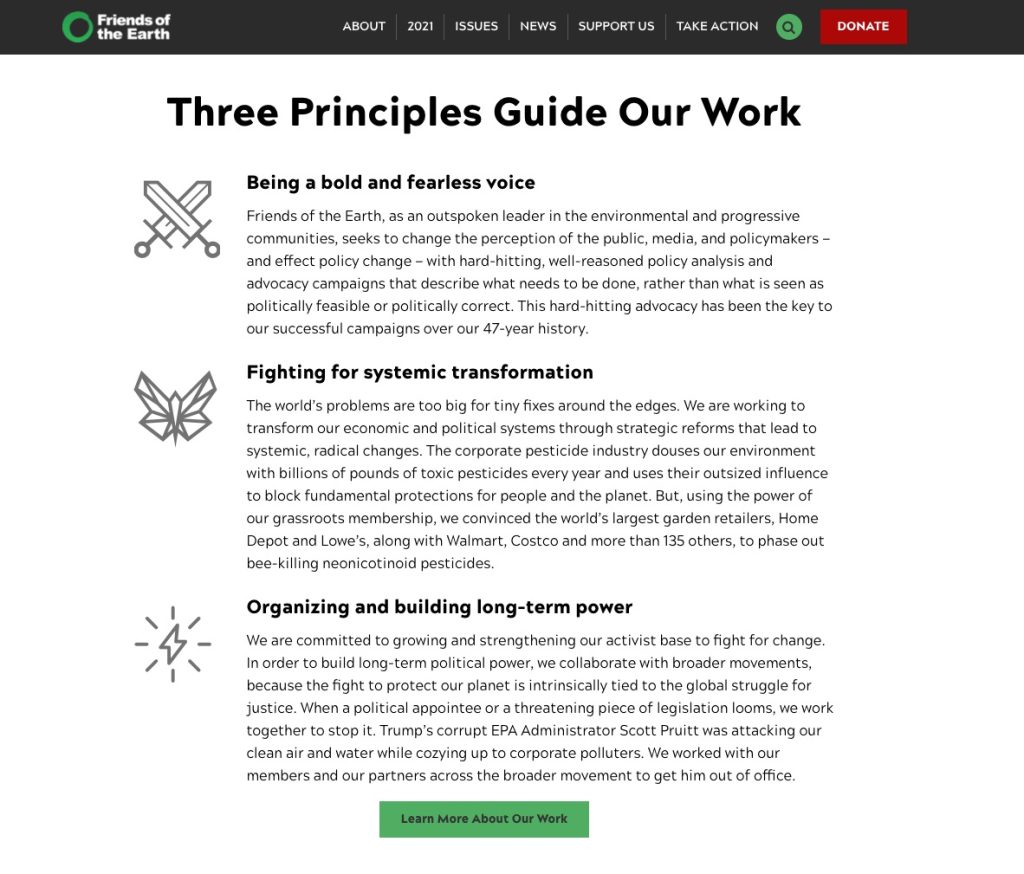
These principles (and this organization’s copywriting style/tone) won’t wow everyone—but remember that they aren’t trying to! They’re trying to speak to their particular audience and set themselves apart in the minds of their ideal donors and volunteers.
… which, hey, brings us nicely to the next point!
Nonprofit Branding Key #3: Audience
One of the biggest mistakes that nonprofits (and commercial organizations, too!) make when trying to develop, refine, or revamp their brand is thinking primarily about themselves. In reality, you need to be thinking about your audience.
This makes sense when you consider the idea that a brand is simply a feeling that your audience has about you.
As Marty Nuemeier says in his book The Brand Gap, a brand is “a person’s gut feeling about a product, service, or organization.”
To make sure you convey the right gut feeling—one that’s based on the work you and the vision you have—you should consider who it is you’re talking to and how to best express your vision, mission, values, and purpose to that specific audience.
Questions to Identify and Understand Nonprofit Audience

The most effective nonprofit branding strategy is always built on a thorough understanding of audience. From the very beginning of any project—whether it’s a nonprofit website redesign or an internal brand refresh—it’s worth taking a dedicated look at who your audience is and how you might speak to them more personally, authentically, and intimately.
Ask yourself questions like these:
- Who are you talking to?
- Who are you NOT talking to?
- What makes people proud to associate with you?
- What does this group of people value?
- What is the better future that these people want?
- How can you connect with them?
- What would compel these people to join your mission?
Using Persona Cards to Develop a Clearer Picture of Your Audience
Creating persona cards is a fantastic exercise to work through this aspect of nonprofit branding and brand strategy. By breaking your audience down into subsets with shared characteristics, you can make sure that your brand is connecting with each group in the way that serves that group best.
At Pixel Lighthouse, we work with nonprofits to identify their audience personas as a foundational step toward improving their website’s impact and value. One part of the persona card looks like the example below.

How Audience Should Impact Nonprofit Branding
You know I love examples, so let’s get even more concrete here!
Consider an addiction treatment organization.
Someone could donate to this organization because they own a business in the area and are worried about the impact of drugs on public safety and economic development. Or someone could donate to this organization because they are grieving a sibling who recently overdosed. Both are completely valid and important reasons why a person might spend their limited resources on this specific nonprofit—but they are completely different audiences, right?
The kind of messaging, imagery, and tone that will reach each audience will be vastly different.
So if you’re this organization, you’d need to identify who you’re talking to before you can craft a brand that creates the gut feeling you want to impart—one that inspires your audience to join your work toward the better future they already envision and desire.
Nonprofit Branding Key #4: Story
So you’ve considered your mission, your vision, and your audience… but another essential consideration is how you relate to that audience. And as humans, one of the best ways to relate to one another is in the form of storytelling. (This concept is not at all new, although it’s been repopularized recently by Donald Miller’s StoryBrand framework.)
It all boils down to this: people love stories.
We instantly relate to stories, especially the ones where we play a starring role. As humans, we all make sense of the world through stories, and drawing on that natural human experience can make your nonprofit more memorable.
Let’s look at an interesting study on this point.
Are You a Baker or a Baker?

To drive this point home… Have you ever heard of the “baker/Baker paradox”?
This principle supports the idea that humans have a much better memory for context (AKA, for stories). Here’s what happened: In a study, researchers showed subjects a picture of a man they did not know. Some were told that he is a baker, and some were told that his last name is Baker.
Now guess who could remember this man several days later?
The ones who were told that he is a baker.
The added context—all those rich storytelling elements like imagining a smiling baker or smelling that delectable scent of fresh-baked bread—helped subjects retain this information much better.
Compelling Stories Build Emotional Connections
So how does this relate to your nonprofit brand?
Well, storytelling can come in many forms, ranging from an overarching theme to micro-stories sprinkled across your nonprofit’s web presence.
Here are just a few examples.
- Overall brand story: You can create an explicit or implicit brand story that follows the StoryBrand framework, where your audience is the hero and you’re the guide.
- Founders’ stories: This is often used on About Us pages to explain why a nonprofit exists. Fortunately, unlike many commercial organizations, nonprofits usually have some seriously great origin stories—so don’t be afraid to show them off!
- Testimonials/case studies: As much as possible, these should be featured on your website, in your newsletters, across impact reports, and even on donation pages. The more people can associate your work with a specific human element, the more impact you’ll have. (You can also use an anonymized composite story where ethical considerations prevent you from sharing individual stories.)
- Images and videos: These often tell a story in and of themselves, but combining great visuals with well-written text is one of the most compelling storytelling methods in any medium, whether print or online or in-person.
Nonprofit Branding Examples: Storytelling
Book Trust has a great example of a founder’s story on their About page. This organization connects with website visitors by telling an authentic story of how they came to be, which helps drive the gut feeling that a person will have about this organization in the future.
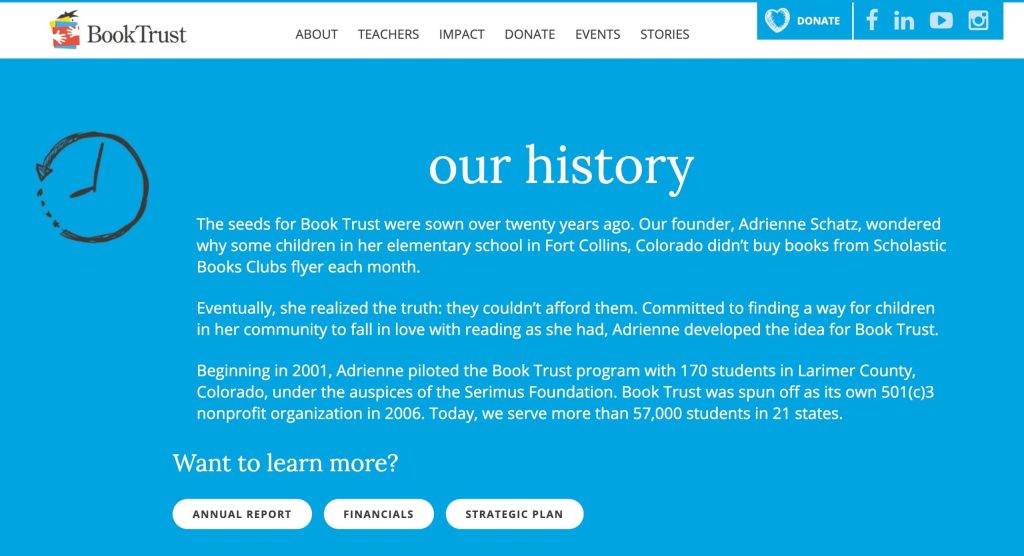
For amazing storytelling woven throughout their site (and really nice nonprofit branding throughout every aspect), another example to check out is Charity Water. This organization puts individual stories front and center on their Why Water? Page. You aren’t “helping people”—you’re directly helping Hadjara, Umu, Natalia, and Devison.
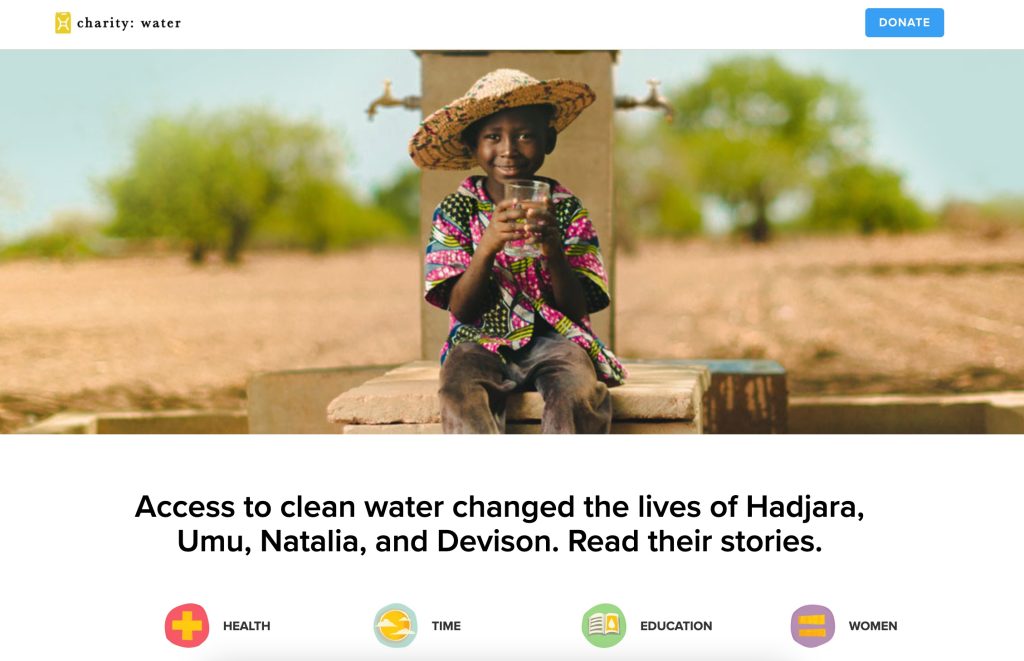
Charity Water even highlights storytelling in their newsletter sign-up feature: “inspiring stories about clean water.”
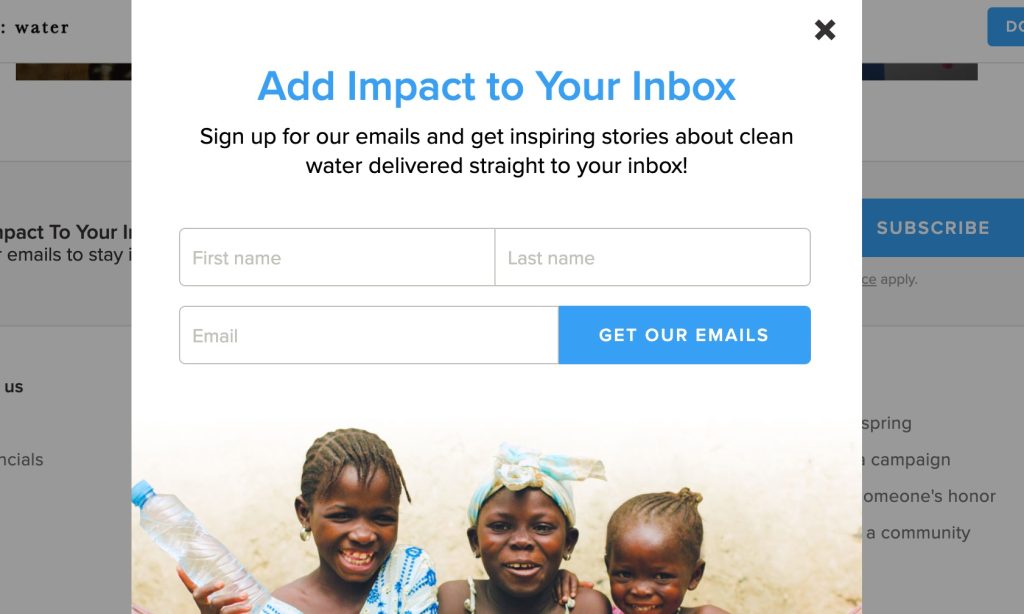
Nonprofit Branding Key #5: Transparency
Transparency is not often found on lists of “what is nonprofit branding,” but it’s something so essential that we’re putting it in ours.
It’s a truly foundational component of a nonprofit and should be given consideration in every aspect of your nonprofit brand: messaging, content structure, images, tone of voice, and more.
The bottom line?
Transparency builds trust, and without trust, even the snazziest, fanciest, most beautiful nonprofit branding won’t make an impact.
A great brand simply shares what you’re already doing—and doing well!—in the most effective, cohesive, and trust-building way possible. Transparency is essential to trust.
Nonprofit Branding Examples: Transparency & Trust
BOCA Helping Hands takes a powerful approach to transparency by providing a wealth of information about what they’re doing—and where they’re going in the future. In addition to the standard impact report, they provide years of financial statements, annual reports, Charity Navigator financial transparency data, and a strategic plan.
All of this is accessible to anyone on their website.
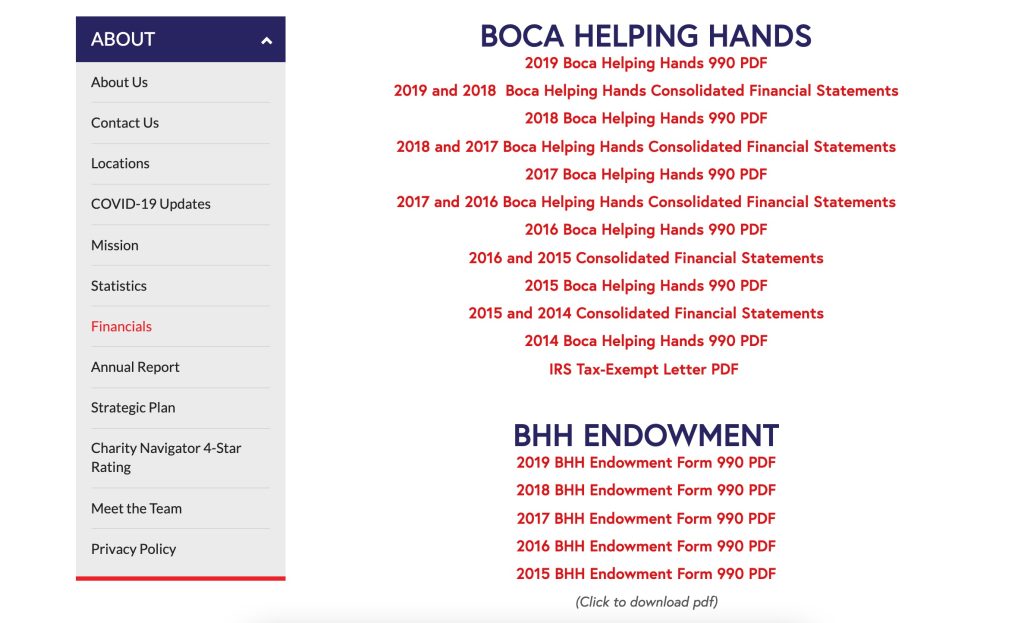
Another terrific example of transparency is GiveWell. This organization rates charities based on their effectiveness, with a brand that’s strongly based on research, objectivity, and evidence-based solutions. This research-heavy brand is reinforced by radical transparency. They don’t hide their previous errors in reporting or research but instead call your attention to them—in the main navigation bar!
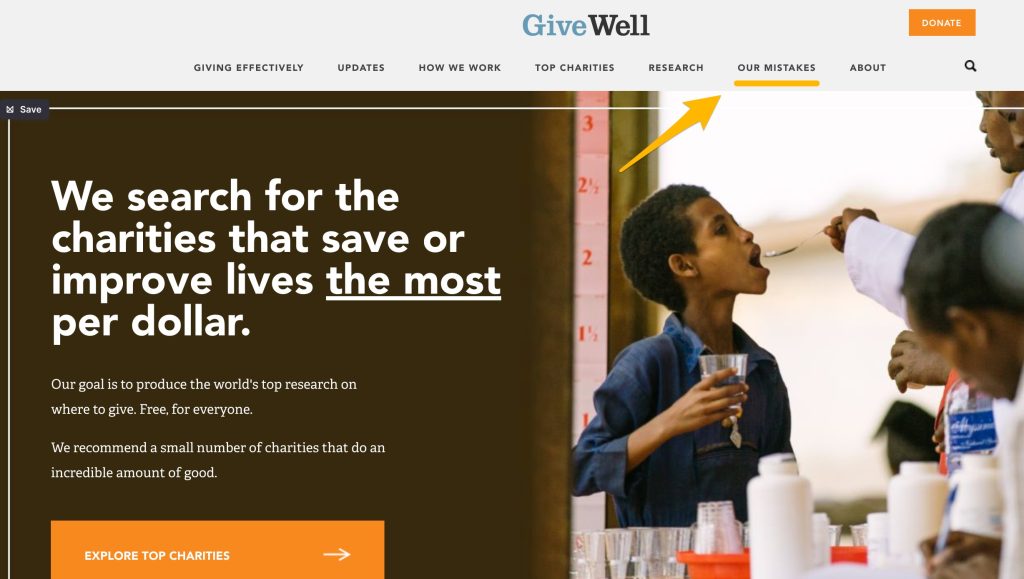
This radical transparency doesn’t take away from the GiveWell brand. Instead, it adds substance and trustworthiness to it.
Nonprofit Branding Key #6: Design & Copy
If you’ve made it this far, you may have been wondering when things like colors, logos, fonts, images, and words would come up. And yep, we’ve finally gotten to them!
Visual design and copy (AKA the words you use) are both important elements of a well-articulated nonprofit brand—but we really want to emphasize this fact: these elements are not good enough on their own. The pretty stuff shouldn’t just be pretty, and the words shouldn’t just “sound good.”
That’s why we’ve placed design and copy last on this list.
The bottom line is this: If you want your visual design and copy to be as effective as possible and to help create a brand that inspires action, then they need to be based on all of the nonprofit brand builders we discussed above:
- Your core values
- Your key differentiators/positioning
- Your unique audience
- Your story and your audience’s story
- Your commitment to transparency (and how that might look in your specific nonprofit space)
The key elements on this list should form the foundation for everything related to design and copy: tone of voice, key messaging, color scheme, brand identity (e.g. your logo), typography, imagery, and more. (For instance, an organization focused on young adults with a straightforward, “no BS” tone would likely want very different copy and design compared to an organization that speaks largely to Baby Boomers who lean conservative and are interested in economic development.)
You can see an example of how copy and design are intertwined with more foundational identity elements in the American Red Cross brand one-sheeter shown below.
While this sheet of course explains the typical visual design elements like color, it also has a separate section for “Tone of Voice”—which focuses primarily on the core values of the organization and how those impact the words they use. They devote precious space on a one-sheet brand guide to discuss core values because they’re that important!
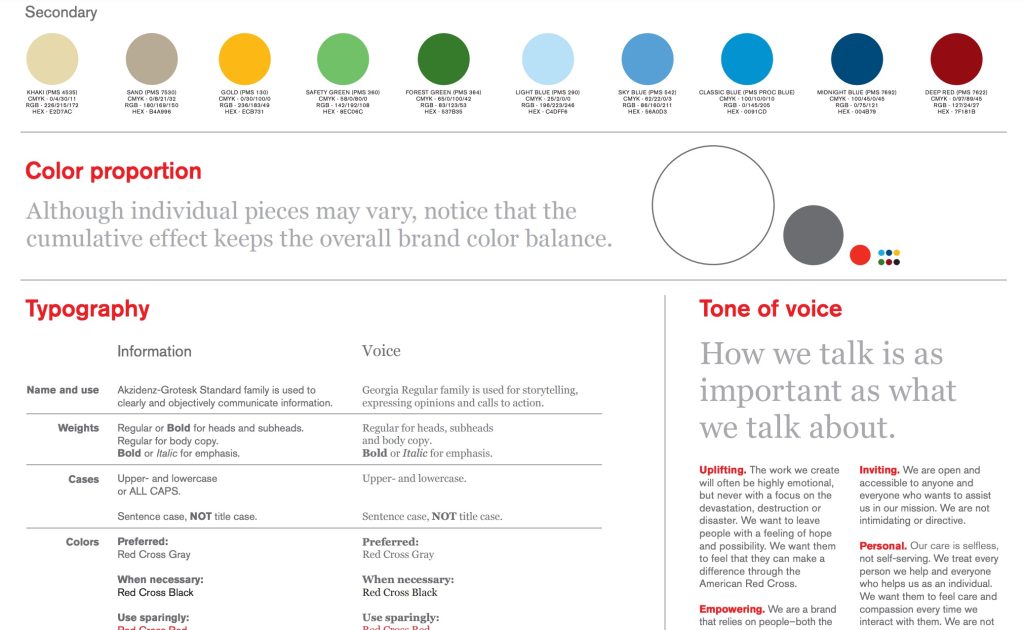
Questions to Consider for Nonprofit Design and Copy
With every copy or design element you choose for your website, social media posts, or other online platforms, you should ask yourself:
- How does [font, color, image, copy, etc.] this reinforce our values?
- How does this [font, color, image, copy, etc.] differentiate us?
- How does this [font, color, image, copy, etc.] speak to our audience? Is it relatable, and why?
- What gut feeling does this [font, color, image, copy, etc.] create? Is it the feeling we want to impart?
- How does this [font, color, image, copy, etc.] tell a story that connects with our people?
Translating these questions into specific copy and visual design choices is one of the most challenging aspects of nonprofit branding, but it’s also one of the most impactful when done well. If you’d like some insight, sign up for a free strategy call.
Nonprofit Branding Examples: Design and Copy
Once you have your copy and design mapped out, it’s basically rinse and repeat!
Check out World Bicycle Relief for an example of well-thought-out design and copy, which comes together to form a nice motif.This organization leans heavily on imagery and wordplay around bicycles, and it really works!World Bicycle Relief invites you not just to help but to keep their wheels turning.
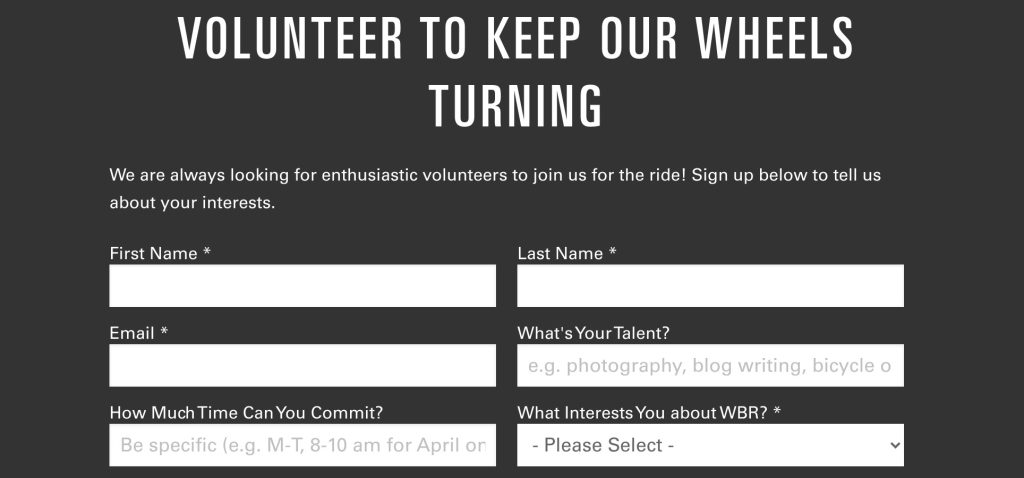
They also use selectively employ their primary brand color (red) to further drive home the word “movement.”

Even though the theme of movement is repeatedly heavily in both imagery and copy across the World Bicycle Relief website, the motif works. It’s used effectively without feeling like it’s “too much.”
One of the biggest rookie mistakes is to sprinkle branding too lightly on your nonprofit website. In most cases, it’s perfectly okay to be a little heavy-handed! Most people scan websites in seconds, so the more you can incorporate your brand voice, design motifs, colors, and imagery, the better.
Starting with Nonprofit Brand Strategy Amplifies Your Impact
With just a bit of strategic thinking around these six brand builders, you can create a brand that is more memorable to your audience and more likely to inspire action.
By starting from your values and expanding from there, you’ll make sure that every choice you make communicates exactly who you are, what you do, and why someone should join you. And that’s the basis for an online presence that grows your impact!
If you’d like to start with a roadmap for your nonprofit brand strategy and/or nonprofit website redesign, contact us to schedule a strategy call.